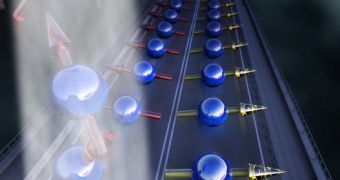Researchers at the Massachusetts Institute of Technology (MIT), in Cambridge, say that the spin of electrons flowing on the surface of materials called topological insulators can be controlled rather easily, by varying the polarization of the light source being used to study the particles.
The discovery was made as the team was working on developing a way of obtaining information about these essential electrons. Understanding how they move is critical to figuring out the full extent of what these novel class of materials can do.
In addition to showing that photons can be used to obtain data on the state of surface electrons, the team was also able to prove that changing the polarization of light can also change the spin of the other elementary particles.
Investigations such as this one are very important because they could open the way to an entirely new class of devices, which will not work based on electrons' electric charge, but on their spin. This is the difference between electronics and spintronics.
There are numerous applications for such a technology, but it could prove to be especially useful in augmenting magnetic data storage capabilities. At this point, topological insulators represent that best materials researchers have access to for such applications.
The thing that separates them from other materials is the fact that they possess an insulating core. The inner structure of the material prevents any electrons from passing through, acting as a conventional insulator. But the outer layers of the material are extremely good insulators.
Based on the new data, it may also become easier for scientists to continue their work on creating quantum computers. These devices would use the two basic principles of quantum mechanics – superposition and entanglement – to carry data in quantum states.
What this means is that a quantum bit (qubit) could exist not only as a “1” or “0,” but also as a “1 and 0” at the same time. The amount of data that such qubits can store is much larger than what current bits can carry, and could enable the creation of tremendously fast processors.
In addition to spintronics – coding data on electrons' spins – researchers are also working on creating devices that use photons to encrypt data. Achieving success in this quest could lead to the creation of computers that communicate and perform operations nearly instantly.

 14 DAY TRIAL //
14 DAY TRIAL //